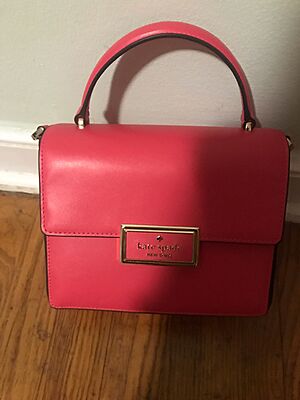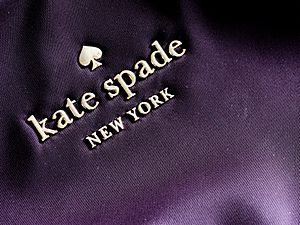Kate Spade New York facts for kids

Kate Spade store on Regent Street
|
|
| Subsidiary | |
| Industry | Fashion |
| Founded | January 1993 in Kansas City, Missouri, U.S. |
| Founders | Andy Spade Kate Spade |
| Headquarters | New York City, U.S. |
|
Number of locations
|
179 stores |
| Products |
|
| Parent | Tapestry, Inc. |
Kate Spade New York is a famous American fashion company. It was started in January 1993 by Kate Spade and Andy Spade. In 2017, a larger company called Tapestry, Inc. bought Kate Spade New York.
Contents
The Story of Kate Spade New York
Kate Spade New York is a well-known fashion brand. It started with handbags and grew to include many other items.
How the Company Began
Katherine Noel Brosnahan, who later became known as Kate Spade, was born in 1962. She grew up in Missouri and went to college in Arizona. There, she met her future husband, Andy Spade.
After college, Kate and Andy moved to New York City in 1986. Kate worked as a style editor for a magazine called Mademoiselle. She left in 1991 to create her own line of handbags. To get ideas, Kate looked at flea markets and old stores. She also studied different styles and materials.
Starting the Business
Kate Spade New York officially began in 1993. Kate and Andy Spade started it with their friends Elyce Arons and Pamela Bell. Andy suggested Kate start a handbag line after she left her magazine job.
The first product was a handbag called the "Sam." Andy used $35,000 from his savings to help make the first handbags. Kate's first collection featured classic shapes and colors. Her bags had a small black label that said "Kate Spade New York." At first, her main customers were people from the upper middle class.
In 1996, the company opened its first store in New York City. The brand quickly became popular.
Growing Bigger
After 1998, Kate Spade New York started to grow a lot. In 1999, a company called Neiman Marcus Group bought a big part of Kate Spade. By 2006, Neiman Marcus Group owned the whole company.
In 2004, Kate Spade had only 13 stores in the United States. The company first sold only handbags. But it soon added many other products. These included stationery, shoes, beauty products, perfume, and clothing. Now, Kate Spade New York products are sold in stores all over the world. By 2004, the company was worth $70 million. Today, Kate Spade has over 180 stores worldwide. Its products are sold in more than 400 other stores.
In 2006, a large clothing company called Liz Claiborne Inc. bought Kate Spade for $124 million. Andy Spade was in charge at first. But in 2007, Liz Claiborne took over running the company.
Kate Spade also opened many outlet stores. These stores offer Kate Spade New York items at lower prices. You can also find Kate Spade products in big department stores. These include Nordstrom, Macy's, and Dillard's. In 2017, Kate Spade New York also launched a special collection with Williams Sonoma. This collection included dinnerware and other home items.
In July 2017, Tapestry, Inc. bought Kate Spade & Company for $2.4 billion. After the passing of Kate Spade in June 2018, Tapestry, Inc. announced they would donate $1 million to help with mental health awareness. They started with a $250,000 donation to Crisis Text Line.
What Kate Spade New York Sells
Kate Spade New York is known for its stylish products.
Handbags and Accessories
Kate Spade's first handbag was sold in January 1993. Soon after, new collections came out. These included glasses, jewelry, and other small accessories. In 2007, the company launched "kate spade at home." This line features bedding, bath items, and things for the home.
In April 2013, Kate Spade New York launched a new perfume called "Live Colorfully." This perfume celebrated the brand's 20th anniversary. Each Kate Spade product comes with a special card. This card tells a bit about Kate and Andy's journey.
Jack Spade: The Men's Line
Jack Spade was the men's clothing and accessory line of the Kate Spade brand. Andy Spade started it in 1999. It was a separate business with its own stores and website. Jack Spade offered bags, wallets, clothes, watches, and tech items for men.
Jack Spade's Style
Jack Spade had a unique style. It was simple, useful, and had a bit of dry humor. Andy Spade wanted the brand to be hard to define. He said, "You can never put your finger on it."
This style was seen in the company's marketing and stores. The stores were designed to feel modern and masculine. The brand believed in being emotionally consistent, even if the look changed.
Jack Spade also tried out different kinds of stores. For example, one store became "Jack & Jimbo's Bike Shop." It sold vintage bikes and cycling gear along with Jack Spade products.
Bags for Men
Jack Spade was famous for its simple, useful bags for men. The bags often had a small label. It usually said "Jack Spade, Warren Street, New York" or just "Jack Spade."
Popular bag types included:
- Messenger bags: These bags had one main section and a flap closure. They were made from materials like canvas, nylon, or leather.
- Duffel bags: The "Wayne duffel" was a well-known style. It was simple, roomy, and strong.
- Coal bags: These were inspired by old bags used to carry coal. They were made of heavy canvas.
Men's Clothing
Jack Spade launched its first clothing line for men in 2006. An Irish designer named Cuan Hanly led the design team. He combined classic British styles with casual American sportswear.
Hanly made sure the clothes fit the "Jack Spade" character. The collections focused on simple designs, good fabrics, and small details. The clothing line helped Jack Spade become a broader lifestyle brand.
Closing Down Jack Spade
In January 2015, Kate Spade & Company decided to close all 12 Jack Spade stores. They also closed another line called Kate Spade Saturday. This was done to focus more on the main Kate Spade New York brand.
After the stores closed, Jack Spade products were sold online and through other stores. However, by November 2017, the separate Jack Spade website was closed. Some Jack Spade items were then sold on the Kate Spade New York website under "Gifts for Him."
Images for kids
-
Store on Madison Avenue





